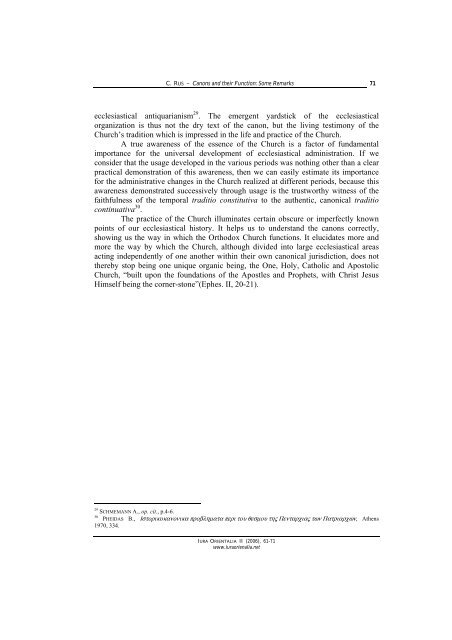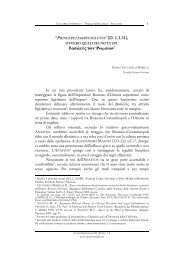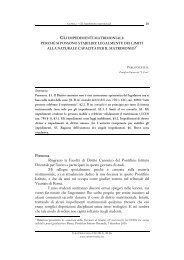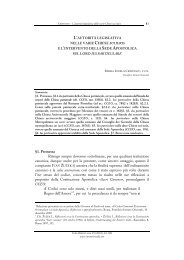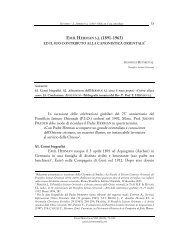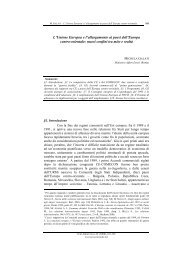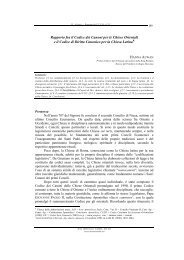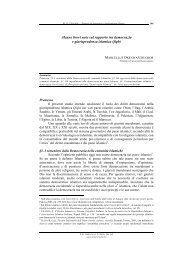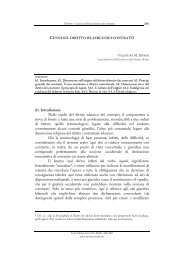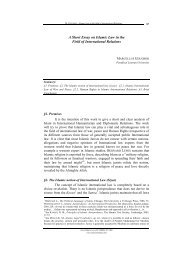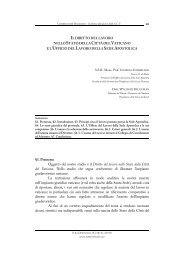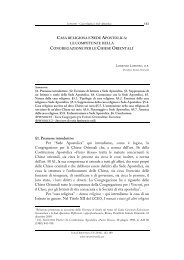C. RUS – <strong>Canons</strong> <strong>and</strong> <strong>the</strong>ir Function: Some Remarks70State, nei<strong>the</strong>r <strong>the</strong> canons nor <strong>the</strong> practice <strong>of</strong> <strong>the</strong> Early <strong>Church</strong> can form <strong>the</strong> basis <strong>of</strong><strong>ecclesiastical</strong> organization» 24 .As MEYENDORFF 25 properly asks, is such a parallel apt? I ask whe<strong>the</strong>r it isexcusable. Can one really write about legal “equality <strong>of</strong> prerogatives” <strong>of</strong> <strong>the</strong>autocephalous churches? Is not <strong>the</strong> <strong>Church</strong> secularized when <strong>the</strong> relations <strong>of</strong> itsmembers with one ano<strong>the</strong>r are seen in such a secular way?Again, if <strong>the</strong> canons <strong>and</strong> <strong>the</strong> practice <strong>of</strong> <strong>the</strong> Early <strong>Church</strong> do not form <strong>the</strong> basis<strong>of</strong> <strong>the</strong> <strong>Church</strong>’s administration, one is naturally faced by <strong>the</strong> question <strong>of</strong> what does.<strong>The</strong> answer is what clearly emerges from <strong>the</strong> Orthodox dogmatic teaching, accordingto which, as TROITSKY later points out, «<strong>the</strong> sole bearer <strong>of</strong> sovereignty in <strong>the</strong> <strong>Church</strong>on earth is <strong>the</strong> entirety <strong>of</strong> its bishops, <strong>the</strong> will <strong>of</strong> which is expressed by its organs, ino<strong>the</strong>r words by <strong>the</strong> Ecumenical <strong>and</strong> local councils».Since TROITSKY maintains that <strong>the</strong> canons <strong>and</strong> practice <strong>of</strong> <strong>the</strong> Early <strong>Church</strong>cannot form a basis, how can he say coherently that <strong>the</strong> bearer <strong>of</strong> sovereignty in <strong>the</strong><strong>Church</strong> on earth is <strong>the</strong> entirety <strong>of</strong> bishops, <strong>the</strong> will <strong>of</strong> which is expressed by <strong>the</strong>Ecumenical <strong>and</strong> local councils? <strong>The</strong> Ecumenical Councils have instituted canons <strong>and</strong>established <strong>ecclesiastical</strong> practice throughout <strong>the</strong> centuries, <strong>and</strong> TROITSKY describes<strong>the</strong>se canons <strong>and</strong> practice. This seems a flagrant contradiction 26 .As far as superficially updating <strong>the</strong> canons is concerned, SESAN indicates <strong>the</strong>danger <strong>of</strong> senselessly replacing <strong>the</strong> ancient canons with new ones, “simply <strong>and</strong> onlybecause <strong>the</strong> new contemporary spirit in <strong>ecclesiastical</strong> life requires it,” <strong>and</strong> he foreseesthat if <strong>the</strong> contemporary transient spirit in <strong>the</strong> life <strong>of</strong> <strong>the</strong> <strong>Church</strong> continues unchecked itwill bring about its downfall, as this modernization could advance beyond <strong>the</strong>organization <strong>and</strong> structure <strong>of</strong> <strong>the</strong> <strong>Church</strong> <strong>and</strong> reach its dogmatic teaching. He writesthat only where <strong>the</strong>re is utilitas evidens <strong>and</strong> necessitas urgens <strong>and</strong> where it serves <strong>the</strong>accomplishment <strong>of</strong> <strong>the</strong> <strong>Church</strong>’s soteriological purpose as was <strong>the</strong> case when <strong>the</strong>ywere enacted must <strong>the</strong> <strong>Church</strong> change <strong>the</strong> early canons 27 . «This we say, not to negateor overthrow what was enacted by <strong>the</strong> Apostles, but out <strong>of</strong> concern for <strong>the</strong> salvation<strong>and</strong> <strong>the</strong> improvement <strong>of</strong> <strong>the</strong> people», as canon twelve <strong>of</strong> <strong>the</strong> Council in Trullo definesit.<strong>The</strong>refore, to make use <strong>of</strong> <strong>the</strong> canons <strong>and</strong> to be within <strong>the</strong> bounds <strong>of</strong> propriety<strong>and</strong> canonicity means initially to know how to identify <strong>the</strong> eternal core in <strong>the</strong> text <strong>of</strong> aparticular canon <strong>and</strong> how to find that side <strong>of</strong> <strong>the</strong> dogmatic teaching <strong>of</strong> <strong>the</strong> <strong>Church</strong>, <strong>and</strong>consequently to apply this eternal element in life, because <strong>the</strong>re is reason in canonicityonly in so far as <strong>the</strong> canon fulfils <strong>the</strong> reason for its promulgation 28 . Faith in <strong>the</strong> canonsis consequently faith in <strong>the</strong> whole <strong>of</strong> <strong>the</strong> <strong>Church</strong>’s tradition, <strong>and</strong> this faith, asFLOROVSKY writes, does not mean faith in <strong>the</strong> external authority <strong>of</strong> <strong>the</strong> past, but is life,is a bound, connection <strong>and</strong> contract with <strong>the</strong> fullness <strong>of</strong> <strong>ecclesiastical</strong> experience.Reference to tradition is not simply historical pro<strong>of</strong>, <strong>and</strong> is not <strong>the</strong> same as24 TROITSKY S., Budem vmeste borotsja s opasnotju, in Journal <strong>of</strong> <strong>the</strong> Moscow Patriarchate (1950), 36-51.25 MEYENDORFF J., Orthodoxie et Catholicity, Paris 1965, 42.26 Ibidem, p. 2027 SESAN V., op. cit., 316. Cf. ARCHONTONIS, On <strong>the</strong> codification <strong>of</strong> <strong>the</strong> sacred canons <strong>and</strong> <strong>the</strong> canonical institution in<strong>the</strong> Orthodox <strong>Church</strong>, <strong>The</strong>ssaloniki 1970, 131-133.28 PETROVIC M., op. cit., 87, 88.IURA ORIENTALIA II (2006), 61-71www.<strong>iura</strong>orienalia.net
C. RUS – <strong>Canons</strong> <strong>and</strong> <strong>the</strong>ir Function: Some Remarks71<strong>ecclesiastical</strong> antiquarianism 29 . <strong>The</strong> emergent yardstick <strong>of</strong> <strong>the</strong> <strong>ecclesiastical</strong>organization is thus not <strong>the</strong> dry text <strong>of</strong> <strong>the</strong> canon, but <strong>the</strong> living testimony <strong>of</strong> <strong>the</strong><strong>Church</strong>’s tradition which is impressed in <strong>the</strong> life <strong>and</strong> practice <strong>of</strong> <strong>the</strong> <strong>Church</strong>.A true awareness <strong>of</strong> <strong>the</strong> essence <strong>of</strong> <strong>the</strong> <strong>Church</strong> is a factor <strong>of</strong> fundamentalimportance for <strong>the</strong> universal development <strong>of</strong> <strong>ecclesiastical</strong> administration. If weconsider that <strong>the</strong> usage developed in <strong>the</strong> various periods was nothing o<strong>the</strong>r than a clearpractical demonstration <strong>of</strong> this awareness, <strong>the</strong>n we can easily estimate its importancefor <strong>the</strong> administrative changes in <strong>the</strong> <strong>Church</strong> realized at different periods, because thisawareness demonstrated successively through usage is <strong>the</strong> trustworthy witness <strong>of</strong> <strong>the</strong>faithfulness <strong>of</strong> <strong>the</strong> temporal traditio constitutiva to <strong>the</strong> au<strong>the</strong>ntic, canonical traditiocontinuativa 30 .<strong>The</strong> practice <strong>of</strong> <strong>the</strong> <strong>Church</strong> illuminates certain obscure or imperfectly knownpoints <strong>of</strong> our <strong>ecclesiastical</strong> history. It helps us to underst<strong>and</strong> <strong>the</strong> canons correctly,showing us <strong>the</strong> way in which <strong>the</strong> Orthodox <strong>Church</strong> functions. It elucidates more <strong>and</strong>more <strong>the</strong> way by which <strong>the</strong> <strong>Church</strong>, although divided into large <strong>ecclesiastical</strong> areasacting independently <strong>of</strong> one ano<strong>the</strong>r within <strong>the</strong>ir own canonical jurisdiction, does not<strong>the</strong>reby stop being one unique organic being, <strong>the</strong> One, Holy, Catholic <strong>and</strong> Apostolic<strong>Church</strong>, “built upon <strong>the</strong> foundations <strong>of</strong> <strong>the</strong> Apostles <strong>and</strong> Prophets, with Christ JesusHimself being <strong>the</strong> corner-stone”(Ephes. II, 20-21).29 SCHMEMANN A., op. cit., p.4-6.30PHEIDAS B., Ιστορικοκανονικα προβληµατα περι του θεσµου της Πενταρχιας των Πατριαρχων, A<strong>the</strong>ns1970, 334.IURA ORIENTALIA II (2006), 61-71www.<strong>iura</strong>orienalia.net


